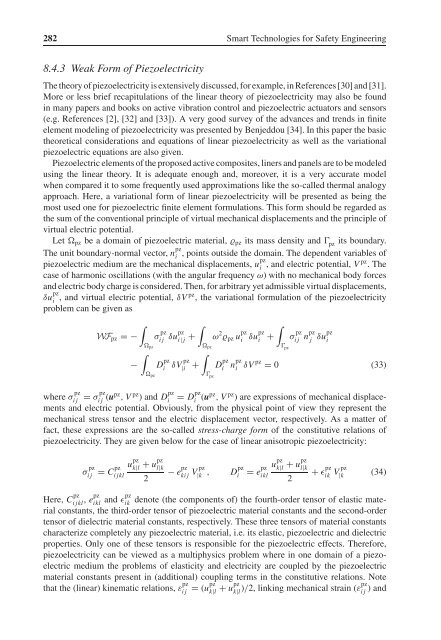smart technologies for safety engineering
smart technologies for safety engineering
smart technologies for safety engineering
You also want an ePaper? Increase the reach of your titles
YUMPU automatically turns print PDFs into web optimized ePapers that Google loves.
282 Smart Technologies <strong>for</strong> Safety Engineering<br />
8.4.3 Weak Form of Piezoelectricity<br />
The theory of piezoelectricity is extensively discussed, <strong>for</strong> example, in References [30] and [31].<br />
More or less brief recapitulations of the linear theory of piezoelectricity may also be found<br />
in many papers and books on active vibration control and piezoelectric actuators and sensors<br />
(e.g. References [2], [32] and [33]). A very good survey of the advances and trends in finite<br />
element modeling of piezoelectricity was presented by Benjeddou [34]. In this paper the basic<br />
theoretical considerations and equations of linear piezoelectricity as well as the variational<br />
piezoelectric equations are also given.<br />
Piezoelectric elements of the proposed active composites, liners and panels are to be modeled<br />
using the linear theory. It is adequate enough and, moreover, it is a very accurate model<br />
when compared it to some frequently used approximations like the so-called thermal analogy<br />
approach. Here, a variational <strong>for</strong>m of linear piezoelectricity will be presented as being the<br />
most used one <strong>for</strong> piezoelectric finite element <strong>for</strong>mulations. This <strong>for</strong>m should be regarded as<br />
the sum of the conventional principle of virtual mechanical displacements and the principle of<br />
virtual electric potential.<br />
Let pz be a domain of piezoelectric material, ϱpz its mass density and Ɣ pz its boundary.<br />
The unit boundary-normal vector, n pz<br />
i , points outside the domain. The dependent variables of<br />
piezoelectric medium are the mechanical displacements, u pz<br />
i , and electric potential, V pz . The<br />
case of harmonic oscillations (with the angular frequency ω) with no mechanical body <strong>for</strong>ces<br />
and electric body charge is considered. Then, <strong>for</strong> arbitrary yet admissible virtual displacements,<br />
δu pz<br />
i , and virtual electric potential, δV pz , the variational <strong>for</strong>mulation of the piezoelectricity<br />
problem can be given as<br />
<br />
WFpz =−<br />
<br />
−<br />
pz<br />
pz<br />
σ pz<br />
ij δupz<br />
i| j +<br />
<br />
D pz pz<br />
i δV|i +<br />
pz<br />
<br />
Ɣ pz<br />
ω 2 ϱpz u pz<br />
i δupz<br />
i +<br />
<br />
σ<br />
Ɣpz pz<br />
ij npz<br />
j δupz<br />
i<br />
D pz<br />
i npz<br />
i δV pz = 0 (33)<br />
where σ pz pz<br />
ij = σij (upz , V pz ) and D pz<br />
i = Dpz<br />
i (upz , V pz ) are expressions of mechanical displacements<br />
and electric potential. Obviously, from the physical point of view they represent the<br />
mechanical stress tensor and the electric displacement vector, respectively. As a matter of<br />
fact, these expressions are the so-called stress-charge <strong>for</strong>m of the constitutive relations of<br />
piezoelectricity. They are given below <strong>for</strong> the case of linear anisotropic piezoelectricity:<br />
σ pz<br />
ij<br />
u<br />
= Cpz<br />
ijkl<br />
pz<br />
k|l + upz<br />
l|k<br />
− e<br />
2<br />
pz<br />
kij<br />
pz<br />
u<br />
V|k , Dpz<br />
i = epz<br />
ikl<br />
pz<br />
k|l + upz<br />
l|k<br />
2<br />
+ ɛ pz pz<br />
ik V|k Here, C pz<br />
ijkl , epz<br />
ikl and ɛpz<br />
ik denote (the components of) the fourth-order tensor of elastic material<br />
constants, the third-order tensor of piezoelectric material constants and the second-order<br />
tensor of dielectric material constants, respectively. These three tensors of material constants<br />
characterize completely any piezoelectric material, i.e. its elastic, piezoelectric and dielectric<br />
properties. Only one of these tensors is responsible <strong>for</strong> the piezoelectric effects. There<strong>for</strong>e,<br />
piezoelectricity can be viewed as a multiphysics problem where in one domain of a piezoelectric<br />
medium the problems of elasticity and electricity are coupled by the piezoelectric<br />
material constants present in (additional) coupling terms in the constitutive relations. Note<br />
) and<br />
that the (linear) kinematic relations, ε pz<br />
ij<br />
= (upz<br />
k|l<br />
+ upz<br />
k|l<br />
)/2, linking mechanical strain (εpz<br />
ij<br />
(34)
















